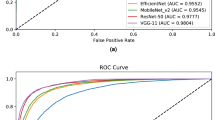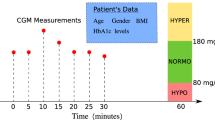Abstract
The current diagnosis of diabetic retinopathy is based on fundus images and clinical experience. However, considering the ineffectiveness and non-portability of medical devices, we aimed to develop a diagnostic model for diabetic retinopathy based on glucose series data from the wearable continuous glucose monitoring system. Therefore, this study developed a novel method, i.e., double deep latent autoencoder, for exploring glycemic variability influence from multi-day glucose data for diabetic retinopathy. Specifically, the model proposed in this research could encode continuous glucose sensor data with non-continuous and variable length via the integration of a data reorganization module and a novel encoding module with fragmented-missing-wise objective function. Additionally, the model implements a double deep autoencoder, which integrated convolutional neural network, long short-term memory, to jointly capturing the inter-day and intra-day glucose latent features from glucose series. The effectiveness of the proposed model is evaluated through a cross-validation method to clinical datasets of 765 type 2 diabetes patients. The proposed method achieves the highest accuracy value (0.89), precision value (0.88), and F1 score (0.73). The results suggest that our model can be used to remotely diagnose and screen for diabetic retinopathy by learning potential features of glucose series data collected by wearable continuous glucose monitoring systems.
Graphical Abstract








Similar content being viewed by others
Data availability
Due to ethical reasons, the data could not be disclosed this time.
References
Antonetti DA, Silva PS, Stitt AW (2021) Current understanding of the molecular and cellular pathology of diabetic retinopathy. Nat Rev Endocrinol 17(4):195–206. https://doi.org/10.1038/s41574-020-00451-4
Sabanayagam C, Banu R, Chee ML et al (2019) Incidence and progression of diabetic retinopathy: a systematic review. Lancet Diabetes Endocrinol 7(2):140–149. https://doi.org/10.1016/S2213-8587(18)30128-1
Vujosevic S, Aldington SJ, Silva P et al (2020) Screening for diabetic retinopathy: new perspectives and challenges. Lancet Diabetes Endocrinol 8(4):337–347. https://doi.org/10.1016/S2213-8587(19)30411-5
Ting DSW, Cheung CY, Nguyen Q et al (2019) Deep learning in estimating prevalence and systemic risk factors for diabetic retinopathy: a multi-ethnic study. Npj Digital Medicine 2(1):24. https://doi.org/10.1038/s41746-019-0097-x
Wong TY, Sabanayagam C (2019) The war on diabetic retinopathy: where are we now? Asia-Pacific Journal of Ophthalmology 8(6):448–456. https://doi.org/10.1097/APO.0000000000000267
AbdelMaksoud E, Barakat S, Elmogy M (2022) A computer-aided diagnosis system for detecting various diabetic retinopathy grades based on a hybrid deep learning technique. Med Biol Eng Compu 60(7):2015–2038
Islam MM, Yang H-C, Poly TN et al (2020) Deep learning algorithms for detection of diabetic retinopathy in retinal fundus photographs: a systematic review and meta-analysis. Comput Methods Programs Biomed 191:105320. https://doi.org/10.1016/j.cmpb.2020.105320
Karakaya M, Hacisoftaoglu RE (2020) Comparison of smartphone-based retinal imaging systems for diabetic retinopathy detection using deep learning. BMC Bioinformatics 21(4):1–18. https://doi.org/10.1186/s12859-020-03587-2
Li L, Sun J, Ruan L, Song Q et al (2021) Time-series analysis of continuous glucose monitoring data to predict treatment efficacy in patients with T2DM. J Clin Endocrinol Metab 106(8):2187–2197. https://doi.org/10.1210/clinem/dgab356
Sartor G, Chilelli NC, Burlina S et al (2013) Association between glucose variability as assessed by continuous glucose monitoring (CGM) and diabetic retinopathy in type 1 and type 2 diabetes. Acta Diabetol 50:437–442. https://doi.org/10.1007/s00592-013-0459-9
Lu J, Ma X, Zhou J et al (2018) Association of time in range, as assessed by continuous glucose monitoring, with diabetic retinopathy in type 2 diabetes. Diabetes Care 41(11):2370–2376. https://doi.org/10.2337/dc18-1131
Hirsch IB (2015) Glycemic variability and diabetes complications: does it matter? Of course it does! Diabetes Care 38(8):1610–1614. https://doi.org/10.2337/dc14-2898
Tao R, Yu X, Lu J et al (2023) A deep learning nomogram of continuous glucose monitoring data for the risk prediction of diabetic retinopathy in type 2 diabetes. Phys Eng Sci Med 46(2):813–825. https://doi.org/10.1007/s13246-023-01254-3
Robinson L, Obeyesekere VR, Jones H et al (2023) Wearing a long-term implanted continuous glucose monitoring (CGM) system vs. conventional CGM in adults with type 1 diabetes—the physical burden. Diabetes 72(Supplement_1):973-P. https://doi.org/10.2337/db23-973-P
Wadehn F, Schaller S, Eissing T et al (2016) A multiscale, model-based analysis of the multi-tissue interplay underlying blood glucose regulation in type I diabetes. In: Annual International Conference of the IEEE Engineering in Medicine and Biology Society. IEEE, pp 1417–21. https://doi.org/10.1109/EMBC.2016.7590974
Villard O, Breton MD, Rao S et al (2022) Accuracy of a factory-calibrated continuous glucose monitor in individuals with diabetes on hemodialysis. Diabetes Care 45(7):1666–1669. https://doi.org/10.2337/dc22-0073
Wang J, Chen Y, Hao S et al (2019) Deep learning for sensor-based activity recognition: a survey. Pattern Recognit Lett 119:3–11. https://doi.org/10.1016/j.patrec.2018.02.010
Lim MH, Cho YM, Kim S et al (2022) Multi-task disentangled autoencoder for time-series data in glucose dynamics. IEEE J Biomed Health Inform 26(9):4702–4713. https://doi.org/10.1109/JBHI.2022.3175928
Zulj S, Carvalho P, Ribeiro R et al (2019) Handling missing data in CGM records. In: International Conference on Biomedical and Health Informatics. Springer, pp 420–7. https://doi.org/10.1007/978-3-030-30636-6_57
Yu M, Quan T, Peng Q et al (2022) A model-based collaborate filtering algorithm based on stacked AutoEncoder. Neural Comput Appl 34:2503–2511. https://doi.org/10.1007/s00521-021-05933-8
Zavrak S, İskefiyeli M (2020) Anomaly-based intrusion detection from network flow features using variational autoencoder. IEEE Access 8:108346–108358. https://doi.org/10.1109/ACCESS.2020.3001350
D’Angelo G, Palmieri F (2021) Network traffic classification using deep convolutional recurrent autoencoder neural networks for spatial–temporal features extraction. J Netw Comput Appl 173:102890. https://doi.org/10.1016/j.jnca.2020.102890
Sun Q, Ge Z (2020) Gated stacked target-related autoencoder: a novel deep feature extraction and layerwise ensemble method for industrial soft sensor application. IEEE Trans Cybern 52(5):3457–3468. https://doi.org/10.1109/TCYB.2020.3010331
Yu J, Zhou X (2020) One-dimensional residual convolutional autoencoder based feature learning for gearbox fault diagnosis. IEEE Trans Industr Inf 16(10):6347–6358. https://doi.org/10.1109/TII.2020.2966326
Dhruv K, Jaipal S.G., Manish G. et al (2019) MVAE: multimodal variational autoencoder for fake news detection. In: World Wide Web Conference, pp 2915–21. https://doi.org/10.1145/3308558.3313552
Ge X, Qu Y, Shang C et al (2022) A self-adaptive discriminative autoencoder for medical applications. IEEE Trans Circuits Syst Video Technol 32(12):8875–8886. https://doi.org/10.1109/TCSVT.2022.3195727
Liu CL, Hsaio WH, Tu YC (2018) Time series classification with multivariate convolutional neural network. IEEE Trans Industr Electron 66(6):4788–4797. https://doi.org/10.1109/TIE.2018.2864702
Li Y, Zhu Z, Kong D et al (2019) EA-LSTM: evolutionary attention-based LSTM for time series prediction. Knowl-Based Syst 181:104785. https://doi.org/10.1016/j.knosys.2019.05.028
Livieris IE, Pintelas E, Pintelas P (2020) A CNN–LSTM model for gold price time-series forecasting. Neural Comput Appl 32:17351–17360. https://doi.org/10.1007/s00521-020-04867-x
Zhang L, Cai Y, Huang H et al (2022) A CNN-LSTM model for soil organic carbon content prediction with long time series of MODIS-based phenological variables. Remote sensing 14(18):4441. https://doi.org/10.3390/rs14184441
Wang J, Cheng S, Tian J et al (2023) A 2D CNN-LSTM hybrid algorithm using time series segments of EEG data for motor imagery classification. Biomed Signal Process Control 83:104627. https://doi.org/10.1016/j.bspc.2023.104627
Lafabregue B, Weber J, Gancarski P et al (2022) End-to-end deep representation learning for time series clustering: a comparative study. Data Min Knowl Disc 36(1):29–81. https://doi.org/10.1007/s10618-021-00796-y
Ismail Fawaz H, Forestier G, Weber J et al (2019) Deep learning for time series classification: a review. Data Min Knowl Disc 33(4):917–963. https://doi.org/10.1007/s10618-019-00619-1
Varghese JS, Ho JC, Anjana RM et al (2021) Profiles of intraday glucose in type 2 diabetes and their association with complications: an analysis of continuous glucose monitoring data. Diabetes Technol Ther 23(8):555–564. https://doi.org/10.1089/dia.2020.0672
van der Linden J, Welsh JB, Walker TC (2021) Sustainable use of a real-time continuous glucose monitoring system from 2018 to 2020. Diabetes Technol Ther 23(7):508–511. https://doi.org/10.1089/dia.2021.0014
Zhao J, Mao X, Chen L (2019) Speech emotion recognition using deep 1D & 2D CNN LSTM networks. Biomed Signal Process Control 47:312–323. https://doi.org/10.1016/j.bspc.2018.08.035
Medtronic MiniMed. “iPro2 User Guide.” www.medtronicdiabetes.com. Accessed November 12, 2017
Zhu Z, Khan MA, Wang SH et al (2023) RBEBT: a ResNet-based BA-ELM for brain tumor classification. Comput Mater Contin 74(1):101–111. https://doi.org/10.32604/cmc.2023.030790
Al Fahoum A (2023) Enhanced cardiac arrhythmia detection utilizing deep learning architectures and multi-scale ECG analysis. Tuijin Jishu/J Propulsion Technol 44(6):5539–5554
Maćkiewicz A, Ratajczak W (1993) Principal components analysis (PCA). Comput Geosci 19(3):303–342
Pedregosa F, Varoquaux G, Gramfort A et al (2011) Scikit-learn: machine learning in Python. J Mach Learn Res 12(1):2825–2830
Noering FKD, Schroeder Y, Jonas K et al (2021) Pattern discovery in time series using autoencoder in comparison to nonlearning approaches. Integr Comput-Aided Eng 28(3):237–256. https://doi.org/10.3233/ICA-210650
Yu W, Kim IY, Mechefske C (2021) Analysis of different RNN autoencoder variants for time series classification and machine prognostics. Mech Syst Signal Process 149:107322. https://doi.org/10.1016/j.ymssp.2020.107322
Amiriparian, S., Schmitt, M., Cummins, N., Qian, K., Dong, F., & Schuller, B. (2018, July). Deep unsupervised representation learning for abnormal heart sound classification. In 2018 40th Annual International Conference of the IEEE Engineering in Medicine and Biology Society (EMBC) (pp. 4776–4779). IEEE. https://doi.org/10.1109/EMBC.2018.8513102
Kazemi SM, Goel R, Eghbali S et al (2019) Time2vec: learning a vector representation of time. arXiv preprint arXiv:1907.05321
Janssens ACJW, Martens FK (2020) Reflection on modern methods: revisiting the area under the ROC Curve. Int J Epidemiol 49(4):1397–1403. https://doi.org/10.1093/ije/dyz274
Al Fahoum AS, Abu Al-Haija AO, Alshraideh HA (2023) Identification of coronary artery diseases using photoplethysmography signals and practical feature selection process. Bioengineering 10(2):249. https://doi.org/10.3390/bioengineering10020249
Cammarota G, Ianiro G, Ahern A et al (2020) Gut microbiome, big data and machine learning to promote precision medicine for cancer. Nature reviews gastroenterology & hepatology 17(10):635–648. https://doi.org/10.1038/s41575-020-0327-3
Naeem M, Jamal T, Diaz-Martinez J et al (2019) Trends and future perspective challenges in big data Advances in Intelligent Data Analysis and Applications. In 2019 Proceeding of the Sixth Euro-China Conference on Intelligent Data Analysis and Applications (pp. 309–325). Springer. https://doi.org/10.1007/978-981-16-5036-9_30
Quick D, Choo KKR (2014) Impacts of increasing volume of digital forensic data: a survey and future research challenges. Digit Investig 11(4):273–294. https://doi.org/10.1016/j.diin.2014.09.002
Acknowledgements
We would like to thank all the involved clinicians, nurses, and technicians at Shanghai Clinical Center for Diabetes for dedicating their time and skills to the completion of this study. The authors would like to thank to the editors and anonymous reviewers for their constructive comments and suggestions that have improved the quality of the study.
Funding
This work was supported by the National Natural Science Foundation of China Youth Fund Project (61903071); the National Natural Science Foundation of China (61973067), the Program of Shanghai Academic/Technology Research Leader (22XD1402300), and the Shanghai “Rising Stars of Medical Talent” Youth Development Program–Outstanding Youth Medical Talents (SHWSRS(2021)_099).
Author information
Authors and Affiliations
Contributions
R.T designed the algorithm, analyzed the data, and wrote the paper. R.T, J.Z, J.L, X.Y, and H.L conceived the study and revised the manuscript. J.L, W.L, and Y.W conducted the study and collected the data. Y.H and X.S analyzed the data. X.Y, J.Z, and H.L are the guarantors of this work. All authors read and approved the final manuscript.
Corresponding authors
Ethics declarations
Consent to participate
Informed consent was obtained from individual participants included in the study.
Consent to publication
Patients signed informed consent regarding publishing their data.
Additional information
Publisher's Note
Springer Nature remains neutral with regard to jurisdictional claims in published maps and institutional affiliations.
Highlights
• The proposed model is the first end-to-end CGM based DR diagnostic model.
• The novel design of autoencoder proposed the model to extract intra/inter-day features from CGM time series data with fragmentation missing.
• The performance of the model has been validated on real-clinical dataset.
Supplementary Information
Below is the link to the electronic supplementary material.
Rights and permissions
Springer Nature or its licensor (e.g. a society or other partner) holds exclusive rights to this article under a publishing agreement with the author(s) or other rightsholder(s); author self-archiving of the accepted manuscript version of this article is solely governed by the terms of such publishing agreement and applicable law.
About this article
Cite this article
Tao, R., Li, H., Lu, J. et al. DDLA: a double deep latent autoencoder for diabetic retinopathy diagnose based on continuous glucose sensors. Med Biol Eng Comput 62, 3089–3106 (2024). https://doi.org/10.1007/s11517-024-03120-0
Received:
Accepted:
Published:
Issue Date:
DOI: https://doi.org/10.1007/s11517-024-03120-0




